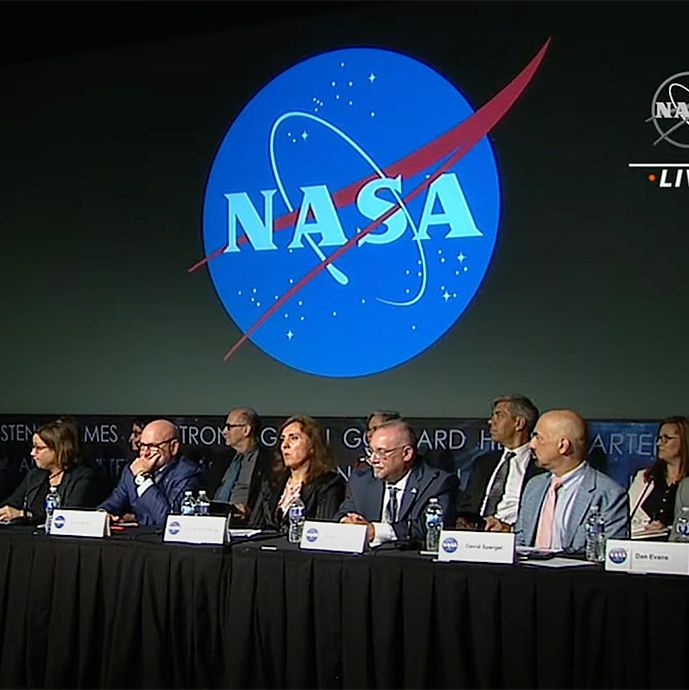Floating Metallic Orbs Are Everywhere — and 4 Other UFO Revelations From NASA

Photo: NASA
The National Aeronautics and Space Administration is finally getting in on the trend of government investigations into unidentified foreign objects. After stating for years that UFO inquiries were below them — both in terms of altitude and reputation — NASA held its first-ever hearing this week on the weird objects that are flying around above us apparently all the time. Below are the main takeaways from the latest federal report on the flying objects, which the government lamely insists on calling unidentified anomalous phenomena.
Sean Kirkpatrick, the head of the Department of Defense’s UFO branch (formally known as the All-Domain Anomaly Resolution Office) spoke at the NASA hearing of strange metallic orbs like one observed by a Reaper drone in the Middle East last year.
While Kirkpatrick said that this particular object “demonstrated no enigmatic technical capabilities,” he did note that these things are everywhere. “We see these all over the world and we see these making very interesting apparent maneuvers,” he said, adding that they’ve noted 800 similar cases of metallic orbs.
Kirkpatrick stated that his research office at the Department of Defense receives around 50 to 100 reports of UFOs (or UAPs – unidentified anomalous phenomena — as they are now known) per month since it was founded last July. But only 2 to 5 percent of those events are “really anomalous,” Kirkpatrick said on Wednesday. “The majority of unidentified objects reported to AARO and in our holdings demonstrate mundane characteristics of readily explainable sources,” he added.
“The majority of unidentified objects reported to AARO and in our holdings demonstrate mundane characteristics of readily explainable sources,” Kirkpatrick explained. “While a large number of cases in AARO’s holdings remain technically unresolved, this is primarily due to a lack of data associated with those cases.”
For Americans paying attention to the glut of UFO news over the past six years, that number checks out at an intuitive level. In 2017, many UFO hopefuls were optimistic that newly-revealed government research into the matter would reveal extraterrestrial activity. But skeptics and further government reports have proven that most of the sightings have clear explanations — usually either military or private-sector unmanned aircraft. The terrestrial nature of many UFO sightings was especially clear this winter, when a Chinese surveillance balloon high above the United States revealed that similar craft had been floating over us for years.
Retired astronaut — and brother to the junior senator from Arizona — Scott Kelly described how easy it is to mistake objects while in flight at tremendously high speeds. Once, when on a mission in an F-14 Tomcat supersonic jet, the flight officer in the back seat thought he saw a UFO. After flying past it, they looped around for another look. “It turns out it was Bart Simpson, a balloon.”
“This environment we operate in is so conducive to optical illusions,” Kelly added. He then showed other videos of unusual objects that had ordinary explanations: three different airplanes mistaken for one glowing troika or, once again, more weather balloons.
Sorry, folks — NASA hasn’t found any aliens either. “There is no conclusive evidence suggesting an extraterrestrial origin for UAPs,” said panel member and science writer Nadia Drake. She did say, though, that better data is needed to get a stronger understanding of what’s actually out there. NASA is expected to deliver a report from the inquiry by August on how to better collect data.
During the panel livestream, several observers on YouTube alleged that NASA was involved in an extraterrestrial cover-up. A form for the public to ask questions included queries like: “Has NASA ever lied to the public regarding UFO topic? If so, provide truthful responses for the three most significant lies.” Nicky Fox, the associate administrator for the NASA’s Science Mission Directorate, said that several panel members had been harassed online for their involvement in the inquiry. Fox discouraged the public from bothering her colleagues. “Harassment only leads to further stigmatization of the UAP field, significantly hindering the scientific process and discouraging others to study this important subject matter,” she said.
This article has been archived for your research. The original version from New York Magazine can be found here.


